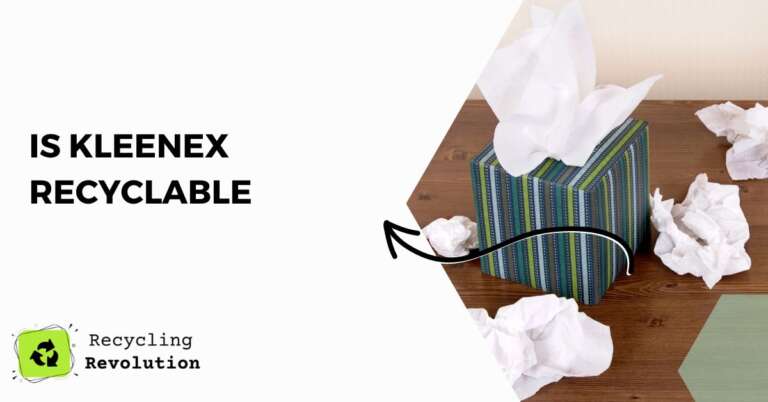In the age of increasing environmental consciousness, recycling has emerged as a powerful tool for combating waste and promoting sustainable living.
Among the everyday items we use, tissues like Kleenex have become virtually indispensable. They’re our go-to for colds, tears, makeup smudges, and everything in between. But this raises a crucial question: Is Kleenex recyclable?
TL;DR: While we would love to share a more positive answer, the hard truth is, Kleenex is not recyclable. Due to its manufacturing process and its typical usage, Kleenex tissues, along with other similar paper tissues, are not suitable for recycling.
Reasons Why Kleenex is Non-recyclable
- Composition and Manufacturing Process: Kleenex tissues are made of virgin fiber, not recycled paper. This fiber is incredibly soft, making it ideal for tissues. However, during manufacturing, these fibers are made even shorter to provide the desired softness, limiting their recycling potential.
- Contamination Risk: Another reason Kleenex isn’t recycled is the potential for contamination. Tissues are often used to wipe away germs, make-up, oils, or even food waste. These contaminants can disrupt the recycling process and potentially ruin an entire batch of recycled materials.
- Absorbency Factor: Kleenex tissues are designed to be highly absorbent, which is great for their intended use but not for recycling. They absorb water quickly, which is problematic in the recycling process that depends on water to break down paper products into pulp.
Alternatives and Eco-friendly Options
While it’s disheartening to learn that Kleenex is non-recyclable, it’s important to remember that there are alternatives available. Let’s explore some of the more eco-friendly options.
- Handkerchiefs: The classic solution. Durable, reusable, and available in many styles, handkerchiefs are a green alternative to disposable tissues.
- Recycled Tissue Brands: Some companies produce tissues from recycled materials. While these tissues still aren’t recyclable due to the reasons mentioned above, their manufacturing process is more environmentally friendly.
- Bamboo Tissues: A fast-growing, sustainable resource, bamboo is a great source of fiber for tissues. Like the recycled options, these tissues aren’t recyclable but are more environmentally friendly to produce.
Breaking Down the Recycling Process
It’s crucial to understand why the recycling process is incompatible with Kleenex. The primary goal of recycling is to recover and repurpose materials. This process typically involves a series of steps, namely collection, processing, manufacturing, and selling.
When it comes to paper products, they’re collected, sorted and then soaked in water to create a slurry or pulp. This pulp is then screened and cleaned to remove any non-paper components, after which it is deinked, bleached, and then converted back into paper.
Unfortunately, as we’ve established, Kleenex doesn’t fit into this process due to its manufacturing and usage patterns. Its fibers are too short and weak to survive this process and be converted into useful products. The high likelihood of contamination and the tissues’ absorbency further hamper their compatibility with the recycling process.
Environmentally Responsible Disposal of Kleenex
Even though Kleenex cannot be recycled, it’s important to consider the most environmentally friendly way to dispose of it. Here’s what I recommend:
- General Waste: It’s suitable to throw your used Kleenex tissues into your regular waste bin. While it’s not an ideal solution, given that tissues aren’t recyclable, this is currently the best available option.
- Composting: Kleenex can also be composted, provided they haven’t been used to clean up chemicals, blood, or disease-laden materials. As tissues decompose, they can contribute to the production of nutrient-rich compost. However, it’s important to balance this with other compost materials to avoid an imbalance in your compost heap.
Choosing Greener Alternatives
In the previous section, we outlined some green alternatives to Kleenex.
- Handkerchiefs: While the upfront environmental cost of producing a handkerchief is higher than that of a single tissue, handkerchiefs can be used hundreds, if not thousands, of times before they need to be replaced. As such, they represent a far more sustainable choice in the long term.
- Recycled Tissue Brands: Recycled tissues are made from recovered paper products, reducing the demand for virgin pulp and hence, the pressure on our forests. This makes them a greener alternative to Kleenex.
- Bamboo Tissues: Bamboo grows extremely fast, making it a more renewable resource than trees. Bamboo tissues also require fewer resources like water and energy in their production, making them an eco-friendly choice.
Informed Consumerism: Always Check the Label
An important aspect of sustainable living is informed consumerism. Always check the labels of the products you buy. Look for tissues made from recycled materials or sustainably sourced bamboo, and avoid products with excessive or non-recyclable packaging.
Note: Some brands might use misleading labels, so it’s crucial to familiarize yourself with the common symbols. For instance, a product stamped with the recycling symbol doesn’t necessarily mean it’s recyclable – it could indicate that the product has been made from recycled materials.
Note: It’s important to remember that while Kleenex tissues are not recyclable, their packaging often is. Check for the recycling symbol on your Kleenex box – this indicates that the box can be recycled in most paper recycling streams.
Conclusion
The unfortunate reality is that Kleenex, while incredibly useful in our daily lives, is not recyclable. The short fibers used in its production, combined with contamination risks and high absorbency, make it unsuitable for the recycling process.
However, this doesn’t mean we can’t make eco-friendly choices. By opting for alternatives like handkerchiefs, recycled tissues, or bamboo tissues, we can reduce our environmental impact while still meeting our needs. And remember, always recycle the Kleenex box, even if you can’t recycle the tissues inside!
FAQs
Can I compost Kleenex?
Yes, Kleenex can be composted. However, be careful not to compost tissues used with chemicals or harmful germs.
Are all tissues non-recyclable?
Most disposable tissues, not just Kleenex, are non-recyclable due to their manufacturing processes and usage patterns.
Can I recycle other Kleenex products, like wet wipes?
Most wet wipes, including those from Kleenex, are non-recyclable. Always check the packaging for specific recycling information.

